- You are here:
- Home »
- Drills & Exercises
Category Archives for Drills & Exercises
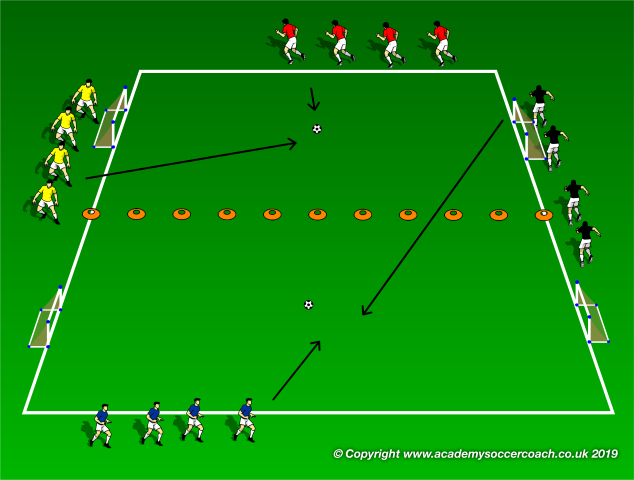
4v4+2
By Søren Schamberg –
Being able to play out of pressure anywhere on the field is essential in both creating space and moving the ball up the field efficiently. This exercise creates situations to demand movement, communication and awareness to improve players abilities to get out of pressing situations.
To set up, create a 10 x 20 rectangle with a dividing line in the middle on the long sides, creating two boxes, 10 x 10 in size.
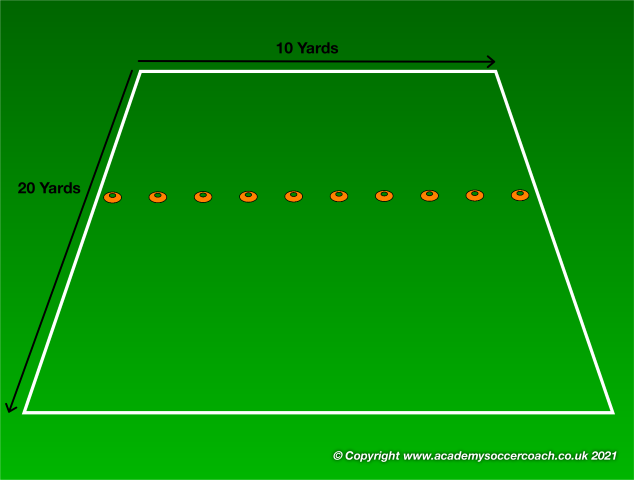
Divide 10 players into 2 teams of 5. Place one player from both teams on the same side of the field and the remaining 4 players from each team on the other side of the field.
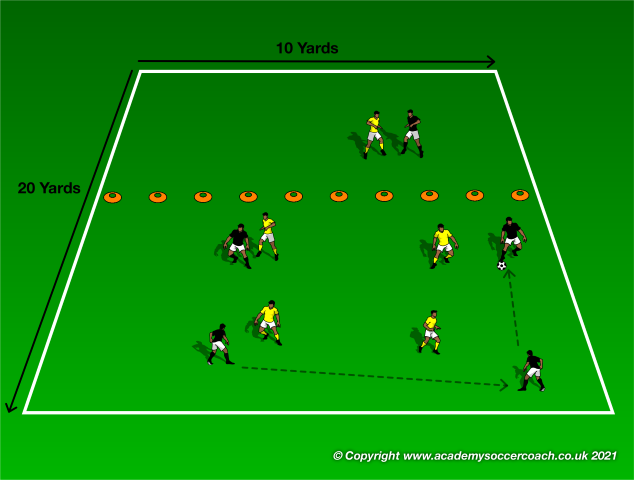
The coach starts the game by passing the ball to the side with the 2 teams of 4 and the team who wins possession attempts to pass the ball to the one player on the other side of the playing area.
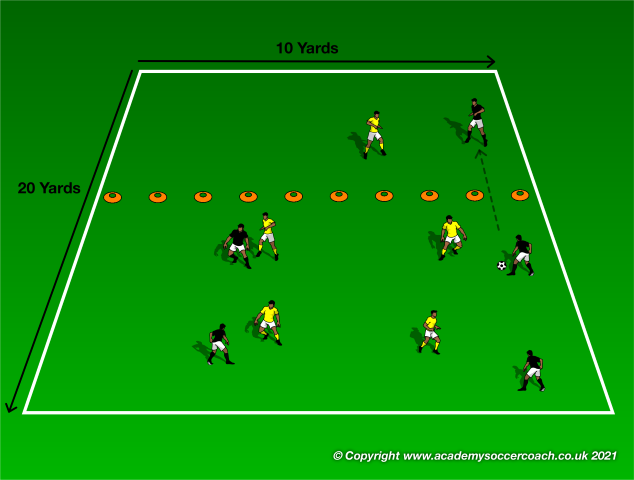
Once the ball is successfully passed to the target player, both teams come into the side while leaving 1 player each behind to become the new target player.
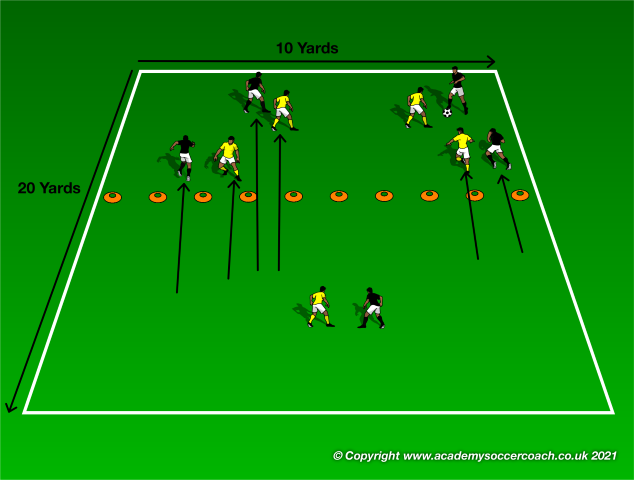
If the ball is turned over, the team trying to pass the ball switches. If the ball goes out of play, the coach will play a new ball in.
Variations
● Successful passes to the target player can be counted as 1 point each
By Søren Schamberg –
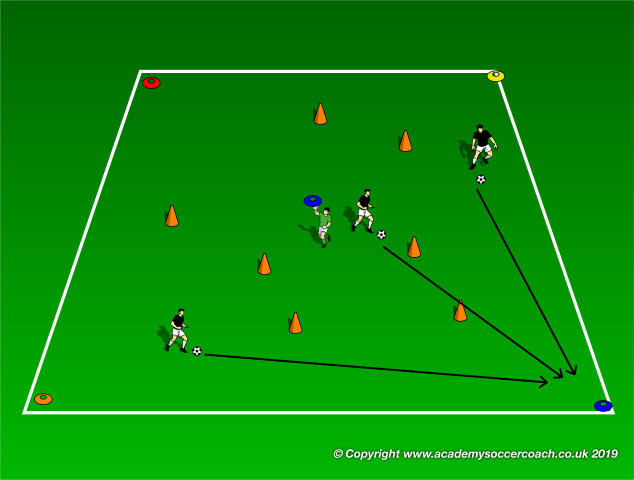
ReACT to Defend
By Søren Schamberg –
When referring to the basics of defending it is easy to make the topic sound simple or the player foolish for not knowing, but this is furthest from the truth. The term “basics” should be reinforced as a foundation to build off of. It is a very slippery slope to get things complicated and over involved that confuses players and overwhelms them with ideas and methodologies to adhere to in a desired system of play. But without the basics, these higher systems fall apart and the team may not realize the success they are capable of and doubt and disbelief keep from progressing throughout a season.
Take for example the tactical application of Pressure-Cover-Balance. Defending as a team and a unit is critical in today’s game. Establishing the method, triggers and communication needed is fundamental, but it’s easy to desire pressure-cover-balance and emphasize it and expect it without addressing the basic 1v1 situations contained in the tactic.
Therefore, 1v1 would be an essential component of the higher function built into pressure-cover-balance and could be considered the “basics”.
I have come to refer to defending 1v1 through an Acronym (Acronyms help me personally remember the procession of steps in a multi step process) as Re.A.C.T. Simply, It stands for Re-cover, Approach, Contain, Tackle and when a game is running in real time it can help a player stay focused on their individual defensive duties.
First, Re-Cover indicates getting into a good defensive position on the field, cutting off passing lanes, being between the player and the goal, all based on how the opponent’s attack is developing.
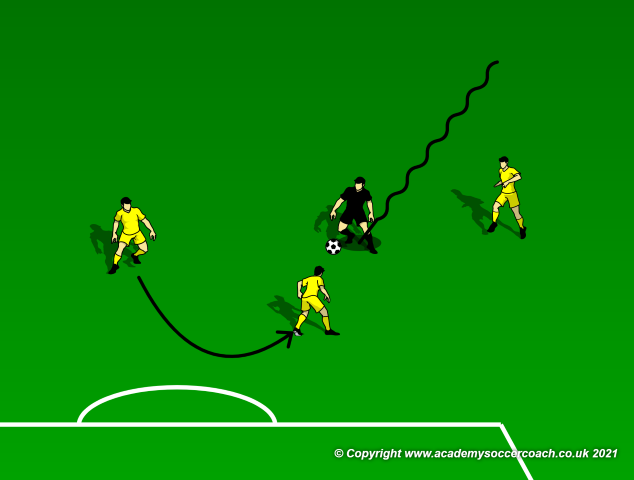
(Figure ReACTtoDefend1-1)
Second is Approach meant to encourage – if the proper conditions are met – a quick approach to the ball carrier to slow or stop the forward movement of the opponent with the ball. This is the familiar sprint and then drop your body position to begin what is the third step.
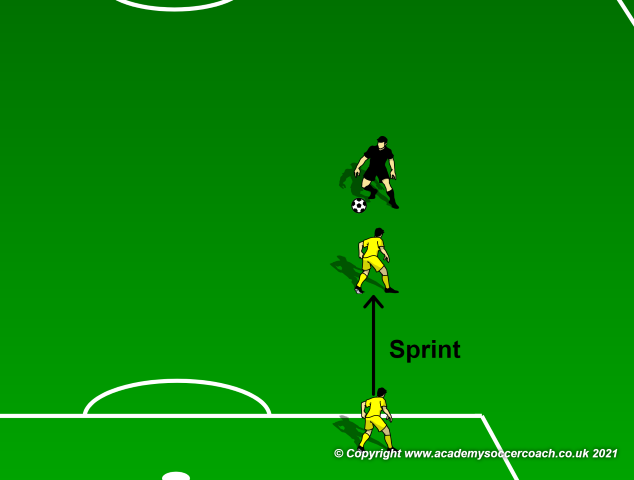
(Figure ReACTtoDefend1-2)
Third is Contain and is meant to encourage containing the ball carrier to either allow the defenders teammates to get into shape or maintain the pressure needed to win the ball back through a bad pass or a fumble with the ball.
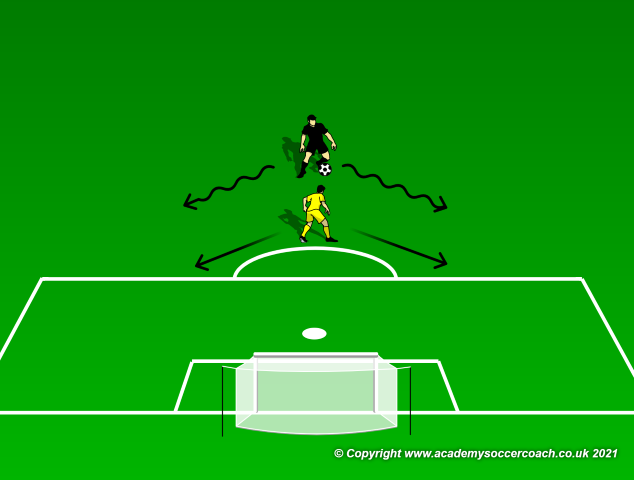
(Figure ReACTtoDefend1-3)
Fourth, – Tackle – is for the last step if Containing doesn’t produce a turnover of possession. Picking the appropriate time to go for the ball to most likely produce a turnover is essential and the least covered in my experience because it deals with patience. This is also positioned last as a way to encourage players’ restraint and not to lunge into a tackle, being easily beat and out of position which is easy to do when patience is out the window.
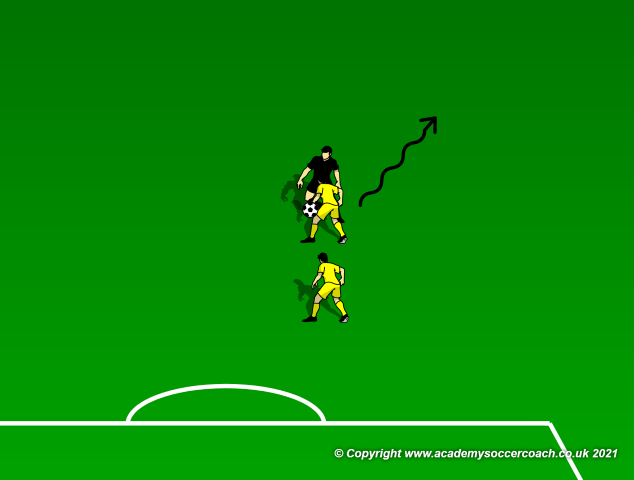
(Figure ReACTtoDefend1-4)
While we as coaches and players recognize that every situation doesn’t unfold on the field in a successive pattern, it is helpful to break it down into steps such as what I have mentioned. After establishing and making the mentioned steps a habit in each individual player, emphasis can be pointed to how quickly or slowly the process can be. Recovering into a good position may produce a bad pass and a tackle (or interception) would be warranted, completely bypassing Approach and Contain. Other situations may be that Approach and Contain is sufficient and the Tackle isn’t needed because the ball is won back because of a bad pass or running the ball out of play.
Whatever the situation on the field, providing players with the tools to recall a basic, standard approach to the situation allows them the ability to make firmly grounded decisions in the moment rather than “winging” it. Once that confidence is there, higher skilled approaches such as Pressure-Cover-Balance become an easier topic to tackle.
I am always interested in knowing if this information was helpful or to have a discussion about any other topics.
By Søren Schamberg –

Competitive Possession Rondo
By Tug McTighe –
Description:
Here is a rondo that is not only good for ball possession and playing quickly, but also incorporates a real competition to ensure that the players aren’t just going through the motions. It works for younger or older players and can be simplified for less skilled players or made more difficult for higher level players if needed.
Setup:
Create four 10×10 or 12×12 grids as shown. Set up 4v1 or 5v2 rondos in opposite corners of the big grid with Black attacking and Yellow defending in one, and Yellow attacking and Black defending in the other.
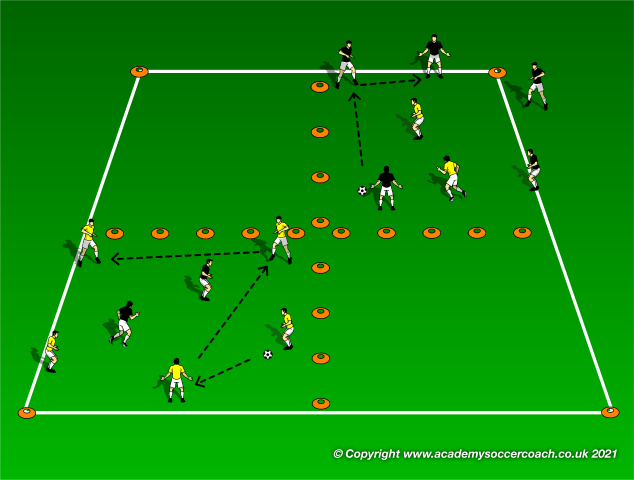
Execution:
Players in each rondo try to connect 4-6 passes (depending on skill level) without the defenders winning the ball. If defenders do win the ball, they quickly give the ball back to the attacking team and we start the connected pass count at 0 again.
NOTE: Defenders defend the whole time, they do not switch out upon winning the ball.
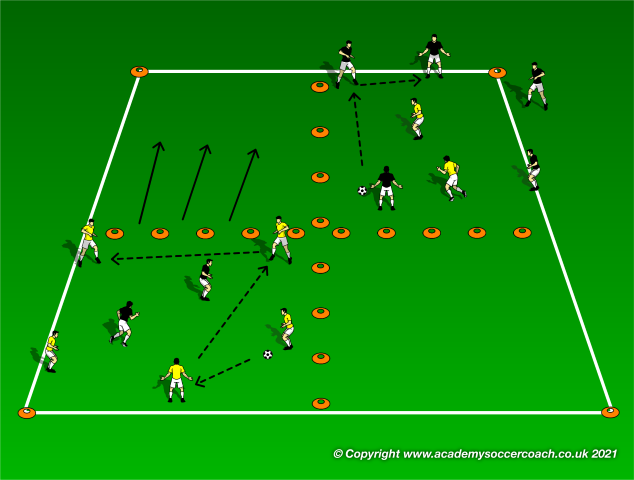
If either team connects the passes they need to connect, all players immediately move into the next grid in a clockwise rotation. They then continue the rondo, trying to connect the winning number of passes again.
The other rondo group stays where they are and tries to connect and move so they don’t get caught. This is the chasing part of the activity.
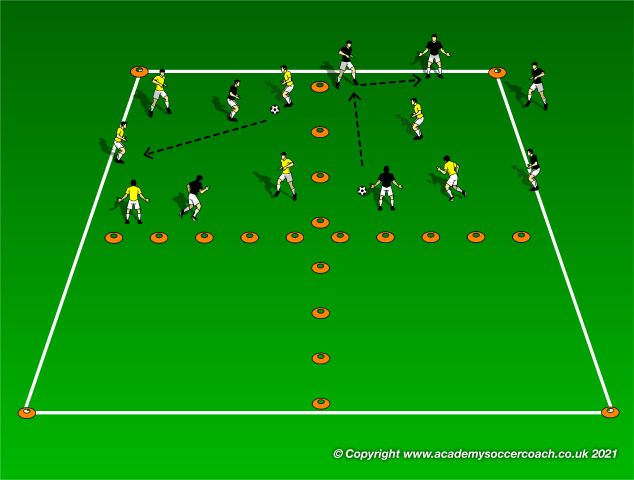
Each round is over when one group catches the other group. At this point we reset, switch player roles and start the next round.
Players can do “punishments” like burpees or push-ups to make the competition real. Keep score and play for a set number of rounds or to time.
By Tug McTighe
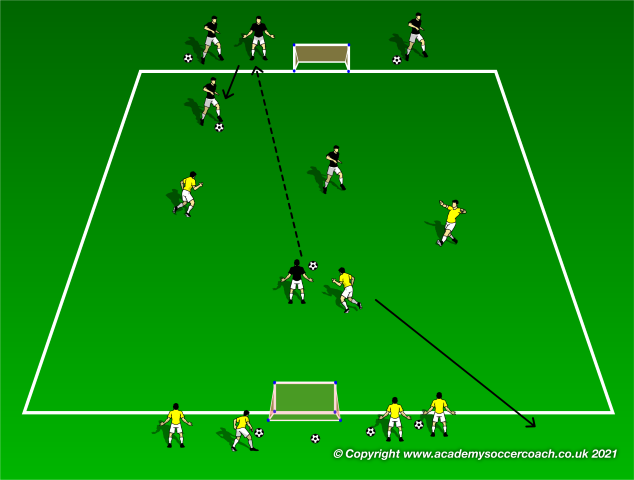
3v2 Bring Them In
By Tug McTighe –
Description:
The purpose of this activity is to help players create and take advantage of overloads. It also forces quick transitions from defending to attacking and back again by making the play continuous.
Setup:
30×20 grid with two small goals as shown. You can vary size and distance between goals per your team’s age and skill level. The smaller the space the more difficult it becomes for the players since they have less time and space.
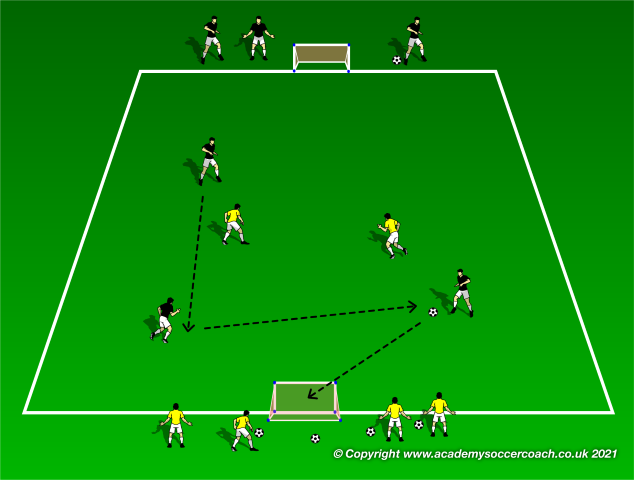
Execution:
3 black players attack 2 yellow players to start. They possess the ball and try to score.
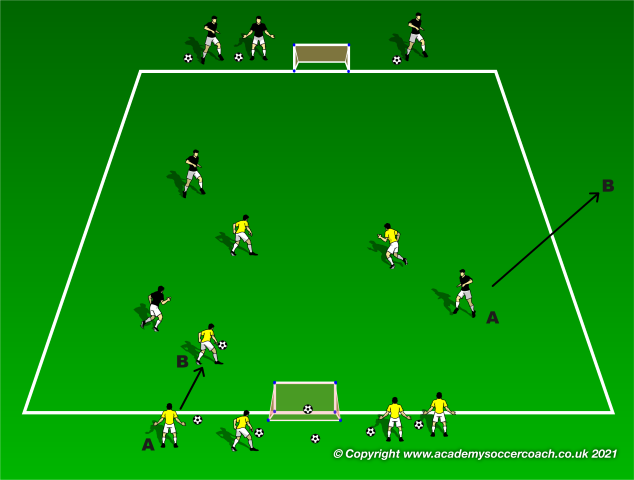
If black team does score, the player that scored immediately leaves the field (Black A to Black B) and a new yellow player comes on with a ball (Yellow A to Yellow B) to make it a 3v2 for yellow.

Yellow now tries to score. But if they are dispossessed, the player that lost the ball exits and the team that won possession must bring their new teammate on by passing the ball backward to one of the waiting players as shown above. They then play 3v2 as normal.
The same thing happens in other situations like a player shooting and missing or even losing the ball out of bounds – they exit quickly and the new player comes on for opposite team to keep the 3v2 going.
Coaching Points:
Find the overload and exploit the 2v1 situations.
Enter and leave the field quickly, the game should be continuous.
You must transition from attack to defense and back again quickly.
You should attack the opponent to create a give and go with your teammate or find the space in behind.
By Tug McTighe

Pass Receive Dribble
By Tug McTighe –
Description:
Since all coaches are strapped for time during training, here is an activity that is great for a practice or a game day warm up that incorporates passing and receiving as well as change of direction and 1v1 moves. All within a simple setup that doesn’t take up much space.
Setup:
Set up 3 passing cones as shown, as well as four cones or markers that will be used for the dribbling part of the activity. You can vary distance for age of players and ability level. 12-15 yards apart should work for most all age groups. The top of the triangle should be 20-25 yards. Depending on how many players you have, you could set up several of the triangles.
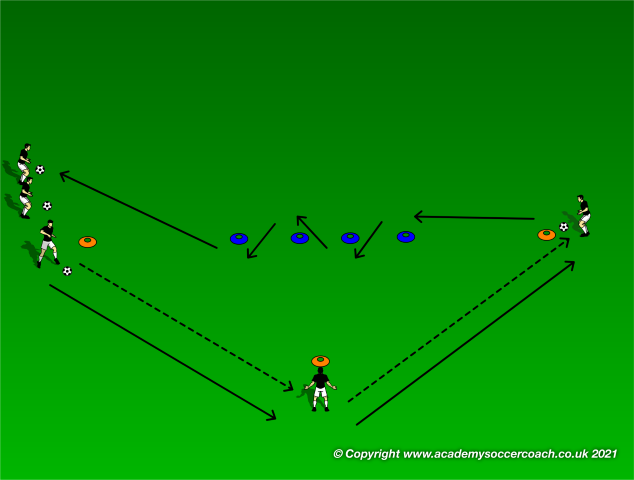
Execution:
Player 1 passes to Player 2. Player 2 passes to Player 3. Each player receives ball and passes to the next player. They then follow their pass to the next cone. Player 3 dribbles to the blue cones, slaloms through them, then dribbles to the end of the line.
Coaching Points:
Pass ball with proper technique and to their proper foot.
Receive ball across body with inside of foot and pass to next player, limiting touches.
Dribble through the cones quickly, but with proper technique, taking many small touches vs fewer large touches.
After a few minutes, make sure to start the ball at the opposite end to cover off on left foot passing/receiving as well.
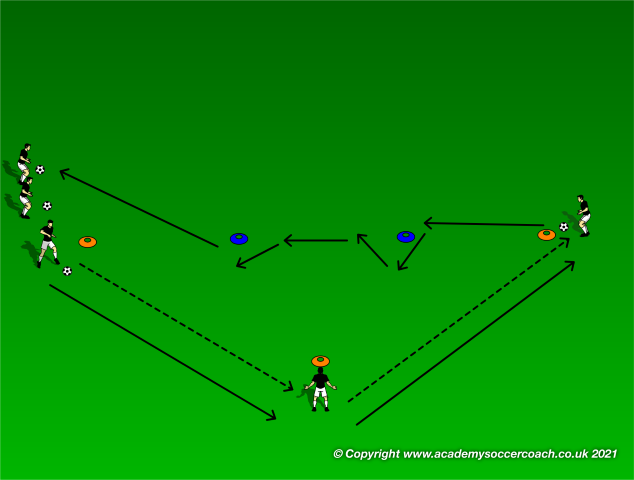
Progression 1:
Remove 2 of the blue cones as shown. Passing/receiving is same, but now the dribbling player does a 1v1 move to beat the first cone, and a 1v1 move to beat the 2nd cone. They then dribble to the end of the line as in previous diagram.
Moves: Scissor, double scissor, lean and push, chop, Maradona – really any move you want them to do.
Progression 2:
Now, rather than a 1v1 move, the dribbling player dribbles to the far cone, does a change of direction move, dribbles to the other cone, does a change of direction move there, and then dribbles to the end of the line.
Moves: Cruyff, outside/inside hook, pull back, pull v, Zico. Again, anything you have worked on.
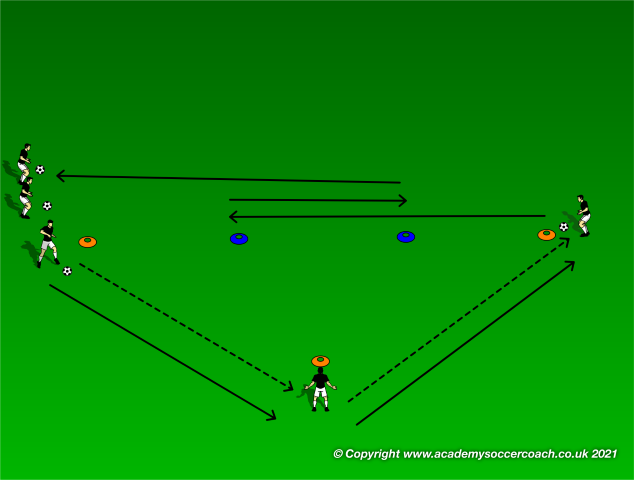
Make sure the activity progresses quickly by having all players ready with a ball, and don’t forget to cover off both left and right foot for passing and receiving every few minutes.
By Tug McTighe

1v1 Control and Compete
By Tug McTighe –
Description:
The purpose of this activity is to force both players to compete for the ball while playing 1v1. By forcing the attacking player to first control the ball, we are making it harder on him to be successful. At the same time, we are giving the defending players many opportunities to look for the visual cues as to when to try to win the ball. There are also many transitional opportunities for both players.
Setup:
15×15 grid with two small goals as shown. Vary size and distance between goals per your team’s age and skill level.
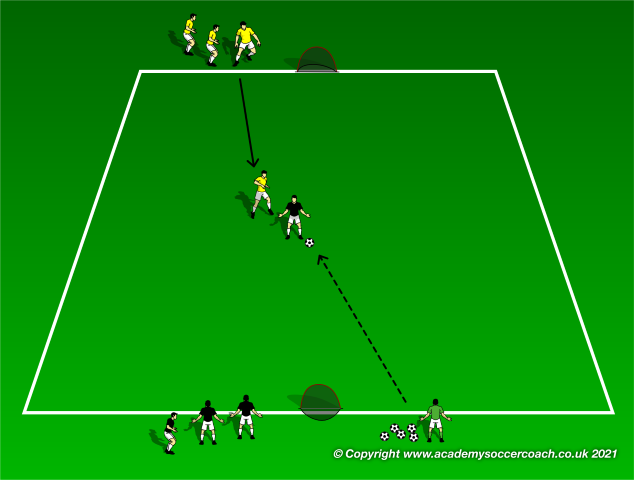
Execution:
Coach plays ball into attacker who tries to control it, turn and take on the defending player 1v1. If attacker scores, we start a new round. If defender wins the ball, they then attack the opposite goal. Play to goal, out of bounds, or to time.
Coaching Points:
Attacking player should check away and try to lose defender
Defending player should look for visual cues – bad touch, bouncing ball – to tackle.
Coach should vary services to make activity more game-like.
Really coach the competitive aspect of this activity for both players.
Variations:
Progression 1: Add a 2nd attacker as shown to play 2v1. Look for white attacker to control ball and bump back to teammate for combination play.
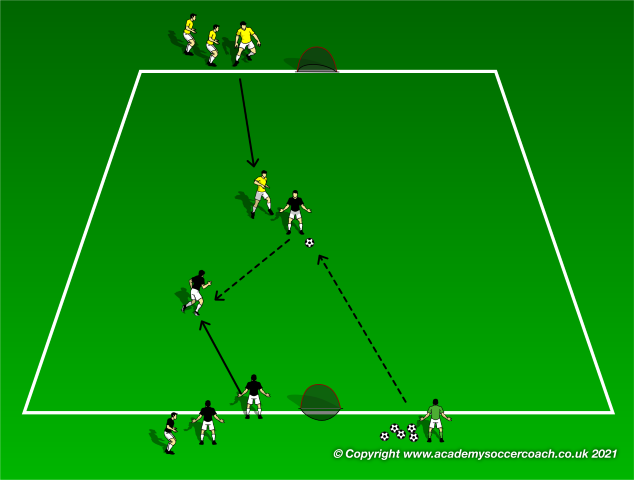
Progression 2:
Add 2nd defender to come in after the ball is controlled by white player to play 2v2.
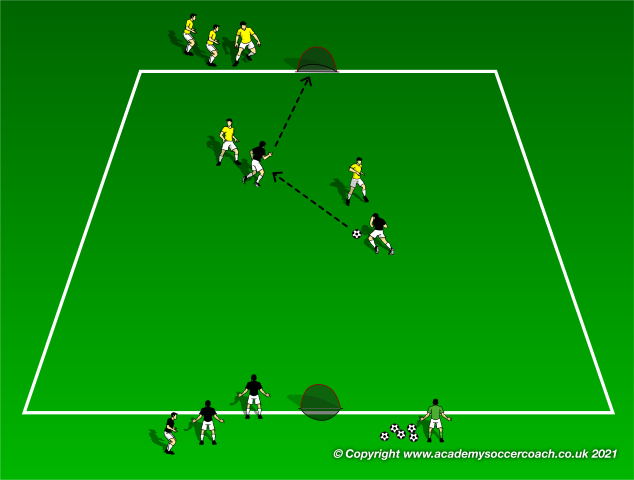
Play 3-4 minutes with one team attacking, then switch and let the other team attack. Keep score so there is always a winner.
By Tug McTighe

Press to Score SSG
By Keith Scarlett –
This is a fast paced small-sided game that will help your players transition from defense to offense and also encourage quick shooting and finishing.
Players play 5v5 in a 40×30 yard grid with one goal on one end.
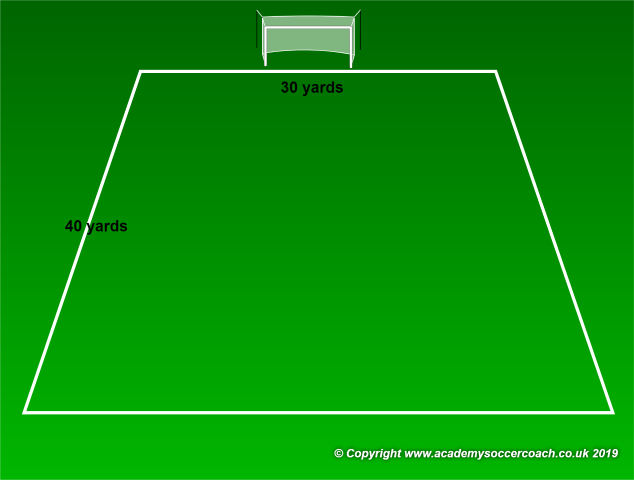
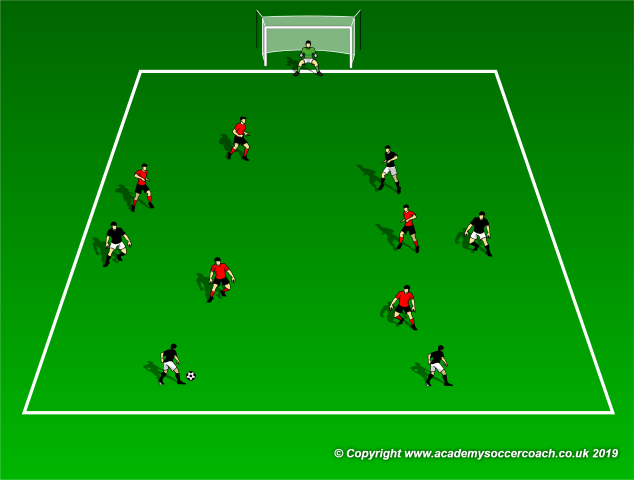
When one team scores, they keep possession. When the defense wins the ball, they become the offense and try to score.
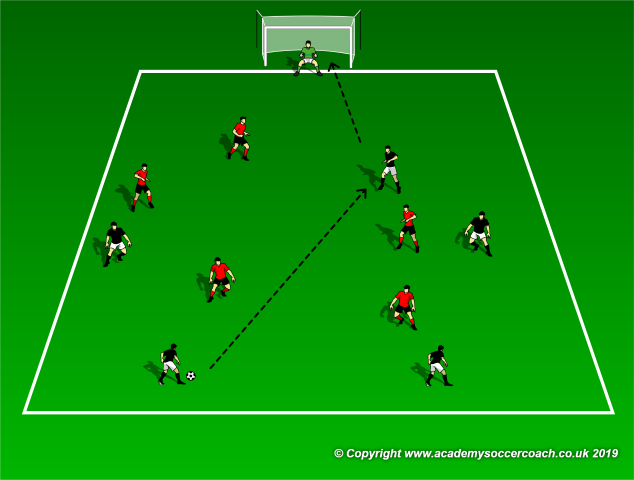
By Keith Scarlett
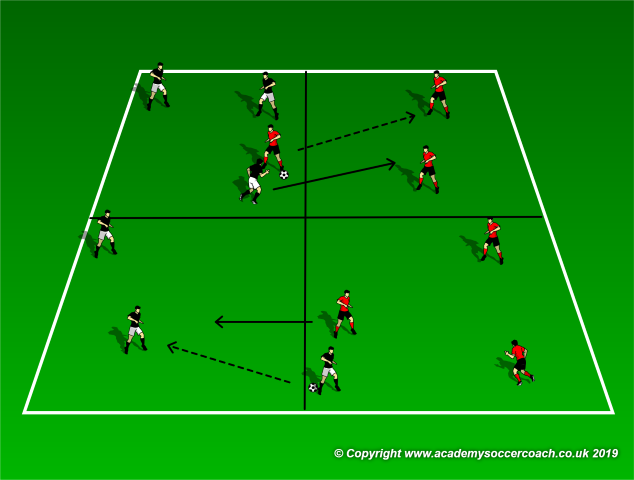
3v1 Possession Drill
By Keith Scarlett –
Line a field into 4 15 yard boxes per the diagram.
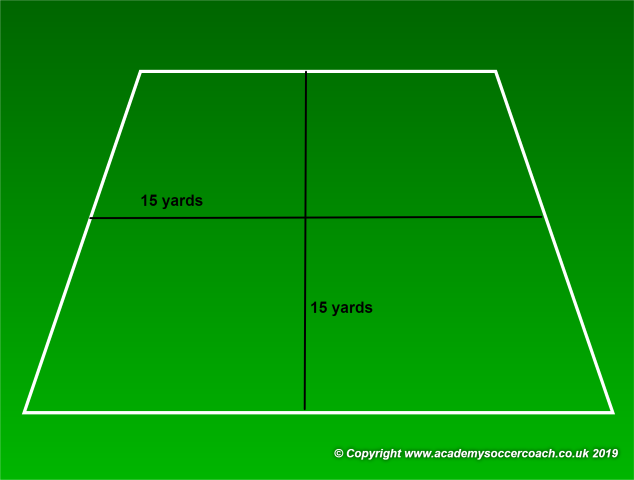
Players are positioned in the grids as the diagram shows.
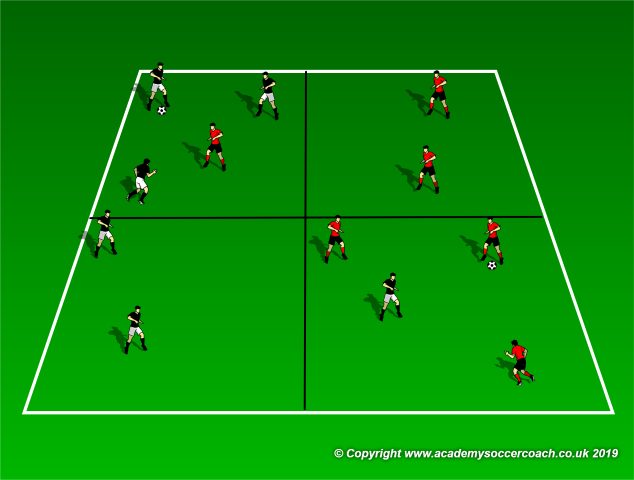
They play 3v1 for possession in their grid.
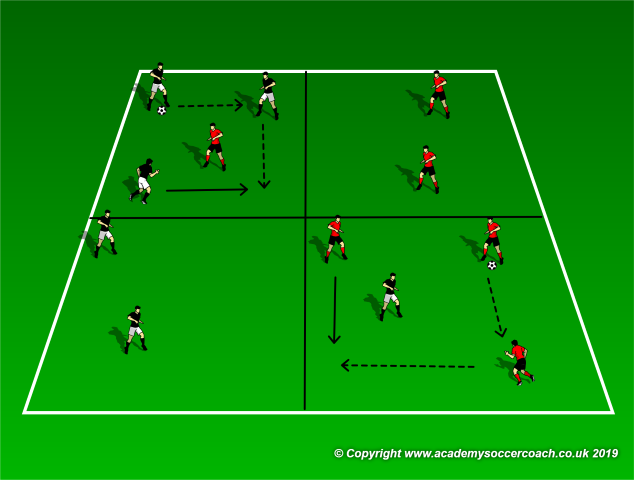
When the defender wins the ball, they immediately transition to the other grid and play in their two teammates. The player who lost the ball trails and plays defense in the new grid.

By Keith Scarlett
